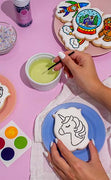
How to Get Your Royal Icing to Dry Shiny
One of the top questions I see posted in cookie groups all the time is “why are my iced cookies drying matte, and how can I get them to dry shiny instead?” Although it might seem like it, I assure you--it's not witchcraft. There are a few simple things you can do to get that pretty, shiny effect, so let's take a look.

"You were born to shine."
The Icing
The journey to shiny cookies starts with the icing itself. It's important to start your icing off on the right foot before you even apply it to the cookie, so let's start there.
Adding corn syrup to your icing can result in a softer bite (who among us didn't make a rock hard royal icing when we first got started, amiright?), but it can also affect the visual result, as well. Recipes that include corn syrup typically add between one tablespoon and ¼ cup per 2lb bag of powdered sugar. As with any new “optional” ingredient, I always recommend starting out on the conservative side and adjusting upwards as desired, but I have definitely found that adding corn syrup to my recipe results in a more consistently-shiny icing at the end of the day.
Overmixing your icing, on the other hand, can cause it to dry more matte. This is one of those aggravating baking terms that can drive you crazy because exactly what the heck does “overmixed” mean?! There is no recipe that says “mix icing for 4 minutes and 17 seconds, and not a second more or your icing will be overmixed.” That would make things too easy. Recipes have to be a little more general, unfortunately (read: “mix for 3-5 minutes”), and so much of the royal icing-making process is in taking visual cues. But an additional two minutes of mixing can be the deciding factor between icing that is perfect and icing that is overmixed, so it's important to keep an eye on your bowl and know when to pull the plug, so to speak. I typically look for my icing to turn a bright white color instead of the dingy wet-powdered-sugar look you start out with. Only once I reach that point do I add white gel food coloring to my bowl; if I add it with the other ingredients at the start, I might miss that visual cue that tells me my icing is done. All that to say, if your icing is drying matte, it might be worth taking a look at how long your mixer is running for.
Drying Aids
One of the main keys to shiny icing is getting that icing to dry quickly. The faster the icing dries, the shinier it will be.
One simple method to faster drying is to just aim a fan at your drying cookies. I like to aim the airflow so that it passes evenly over my cookie sheet, not directly down at a particular cookie. And, of course, you don't want to drag your old bedroom fan out of the attic for this purpose, with its dusty fan blades ready to spread that dust all over your freshly-flooded cookies. Invest in a small, inexpensive fan you can dedicate for this purpose only, keep it covered when you're not using it, and make sure to clean it as needed.
Another (albeit more expensive) option is to invest in a food dehydrator. Choose one with multiple sliding shelves and a fan at the back of the unit that blows evenly over all the shelves at once when in use. I typically set mine to the lowest heat setting possible and pop my cookies in there for 10-15 minutes before removing them and letting them finish drying on a cookie sheet. This gets your icing crusted over and drying ASAP. Just don't let them stay in there too long, or you'll accidentally dry out your actual cookies, too. This is also another case where you do not want to repurpose an old device you have hanging around in your pantry--if your dehydrator smells like beef jerkey, your cookies will also now smell like beef jerkey, so now is not the time to try to cut corners.

So if your Holy Grail is cookies with a glossy, shiny icing, it's worth a try to add one or more of these techniques to your cookie arsenal. You'll be amazed at what a difference speeding up the drying process will make in your end result!
Recommended for You:
Piping Bag Tip Tube Covers - Set of 4
AtecoDon't let your icing bags leak or dry out! Use these covers on bags with Ateco couplers and standard tips on them. Reuse them again and again. Se...
View full detailsBlack Fine Tip Food Marker
The Cookie CountessA black edible-ink pen is essential for your decorating kit. Use these high quality markers for: Marking up baked cookies for planning designs Wr...
View full detailsStainless Steel Measuring Cups 4 Piece Set
The Cookie CountessIncredibly high quality, with no plastic parts. Whether baking or cooking you'll reach for these essentials again and again! THESE ARE THE LAST SET...
View full detailsCookie Order Form 5 x 7, 50 sheets
The Cookie CountessThese cute sheets will help you plan your cookie orders. The back has an area for sketching and pricing planning. Size: 5" x 7" 50 Sheet Pad Doub...
View full details-

Introducing the Cookie Countess Cookie Capsule Collection!
Read nowTired of using boring clear bags as packaging for your beautiful decorated cookies? Or maybe you’ve been looking for a more protective way to package them that is just as pretty as the cookies themselves? Well, look no further than...
-

Stamped Jack-o-Lantern Cookies: an Easy Halloween Treat
Read nowSo you want to make Halloween cookies, but you don't really feel like making or using royal icing? Well, do we have the design for you! Look no further than the Cookie Countess Jack-O-Lantern cutter and stamps set to help...
-

Make and Decorate Easy Mini Jack-o-Lantern Cookies
Read nowHalloween is one of the biggest cookie holidays of the year, and I personally think that can be chalked up to the sheer number of fun/spooky/adorable/creepy designs this holiday lends itself to! Let's look at one of the most basic--Jack-o-Lanterns!...














Comments
Leave a comment